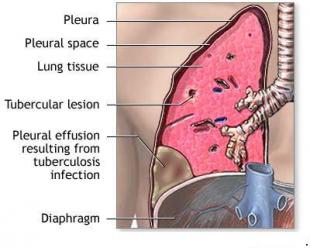
Tuberculosis
Tuberculosisis one of the major causes of illness and death in the underdeveloped countriesas well as the deprived sections of developed countries. Tuberculosis is achronic infectious disease. It is caused by mycobacterium tuberculosis bacteriaand it is contagious. The bacteria first infect the lungs and then spreadthrough the circulatory system to various parts of the body. If left untreated,it can spread to the abdominal organs, kidney and spine. Tuberculosis spreadsthrough contact with infected droplets that are released into the air whilecoughing and sneezing. Those with a weak immune system are more susceptible todeveloping this illness. In some individuals, the infection may remain inactivewithin the body and then emerge later in life when immunity is compromised.Tuberculosis is most rampant in areas which are overpopulated and whereventilation is poor.
Drugabuse and alcohol addiction are also risk factors which increase anindividual’s vulnerability to tuberculosis. The doctor will probably recommenda specific and strict diet for tuberculosis to help recover one’s immunitylevels.
Body changes:
Pulmonarytuberculosis is accomplished by wasting of tissues.
Cough
Expectoration
Fever
Markedrise in body temperature in the early stage
BMRincreases by 20-30% above normal
Inacute stage, the disease is quite similar to that of acute fever
Flushedface
Increasedcirculation
Constantfatigue
Lossof weight
A general run downcondition
Treatment
Rest
Antibiotic therapy
Nourishing food
Love and affection
Dietary treatment:
Energy: Energyneeds are increased to minimize weight loss and achieve desirable weight.Energy intake to be increased by 300-500 kcal/day above the normal intake.
Protein: Serumalbumin is often low. Wasting of body tissues is considerable. Protein intakeis increased and that to of high biological value. About 1.2 – 1.5 gm ofprotein per kg body weight per day. Cereal pulses combination to be emphasizedbesides animal foods to improve protein quality.
CHO and Fats: Enough CHO should be included to meet theenergy requirement. It also helps in spring protein for tissue building. Toomuch fat to be avoided as it frequently causes gastric upsets and diarrhea.
Minerals: Liberalamount of calcium should be given to promote healing of tuberculin lesion. Enoughof vitamin D to be included for proper absorption of calcium. Iron supplementationinclude if patient suffers from hemorrhages.
Vitamins: Conversionof beta carotene to retinol is adversely affected. So diet should provide goodamount of retinol through milk and milk products, egg and meats. Vitamin Crequirement increases as it helps in healing. Vitamin B complex needs are alsoincreased because energy needs are increased. Vitamin B6 requirement alsoincreases because prolonged use of chemotherapeutic agents used in thetreatment may have an adverse effect on its utilization.
Diet and Feeding pattern:
Acute stage high energy,high protein full fluid diet.
As improvement occurs, dietis progressed to a soft and then regular.
Most patients have a poorappetite.
Six meal patterns arepreferred.
Food should be simple and well prepared.
Too much food especially fats, frequentlycauses gastric upsets and diarrhea.
Force feeding to beavoided.
Diet is normal withemphasis on proper selection of foods.
Selection of Food:
Cereal pulse combination.
Khichadi with curd.
Sweet dalia with milk.
Chapati with curd.
Guava, amla and sproutedpulse.
Seasonal vegetable must beprovided amply.